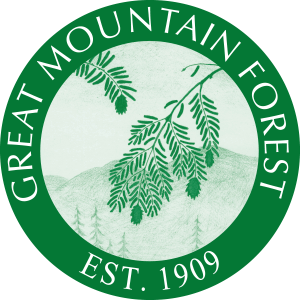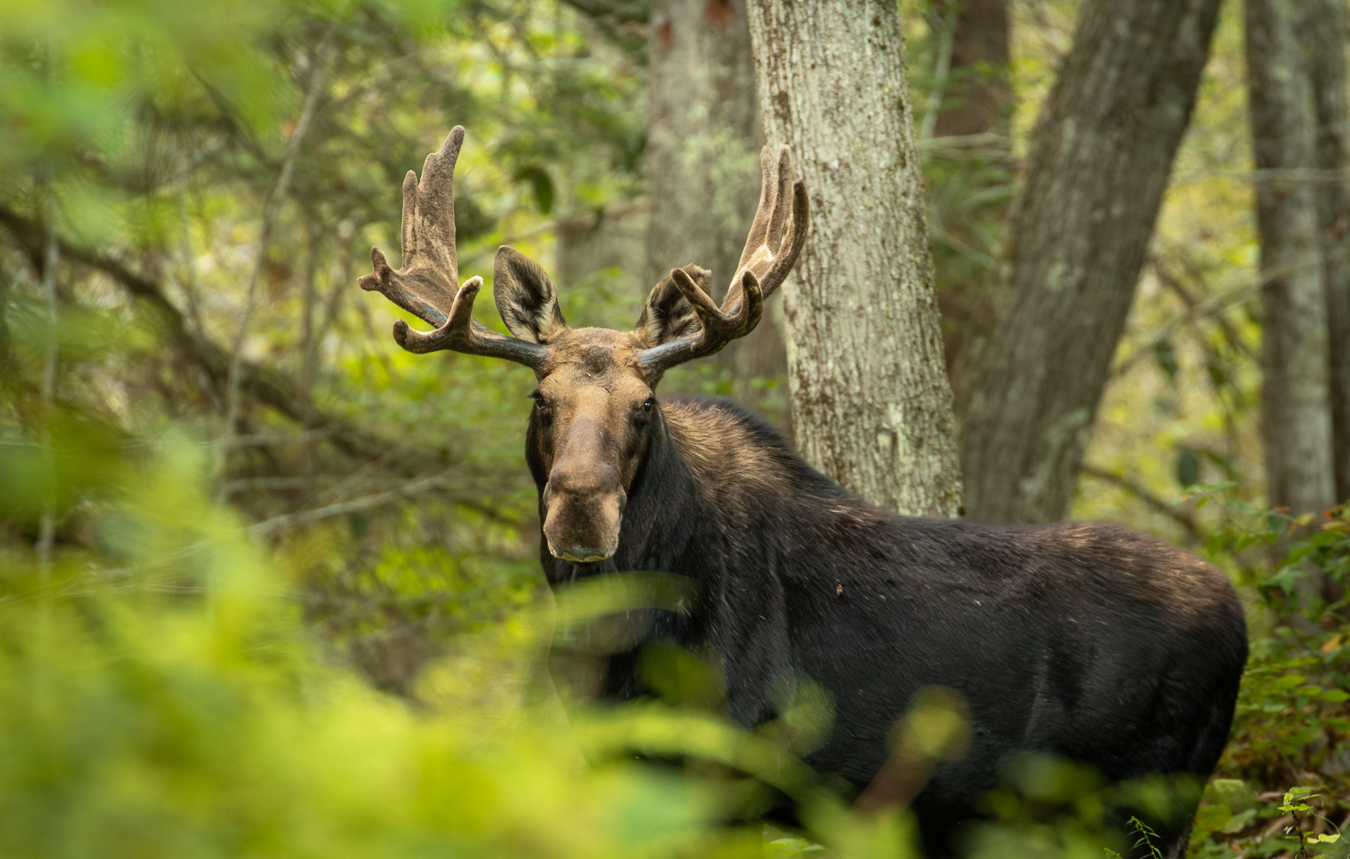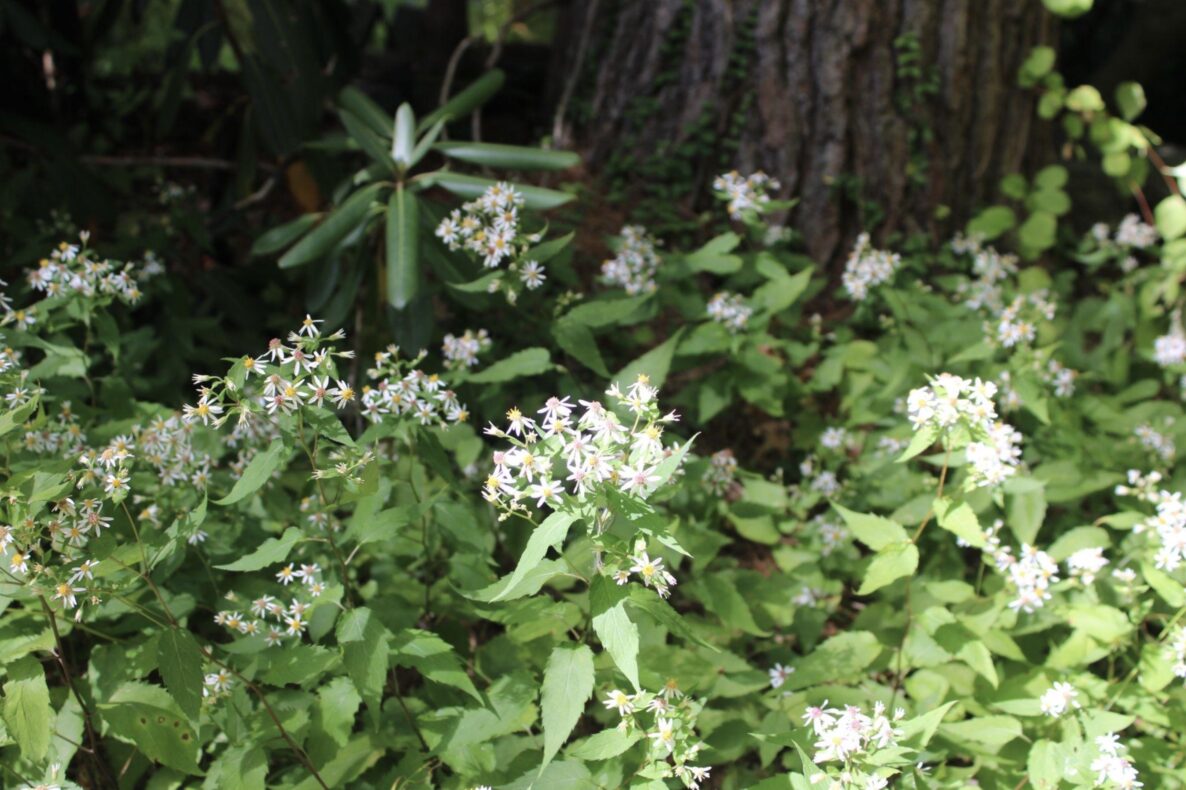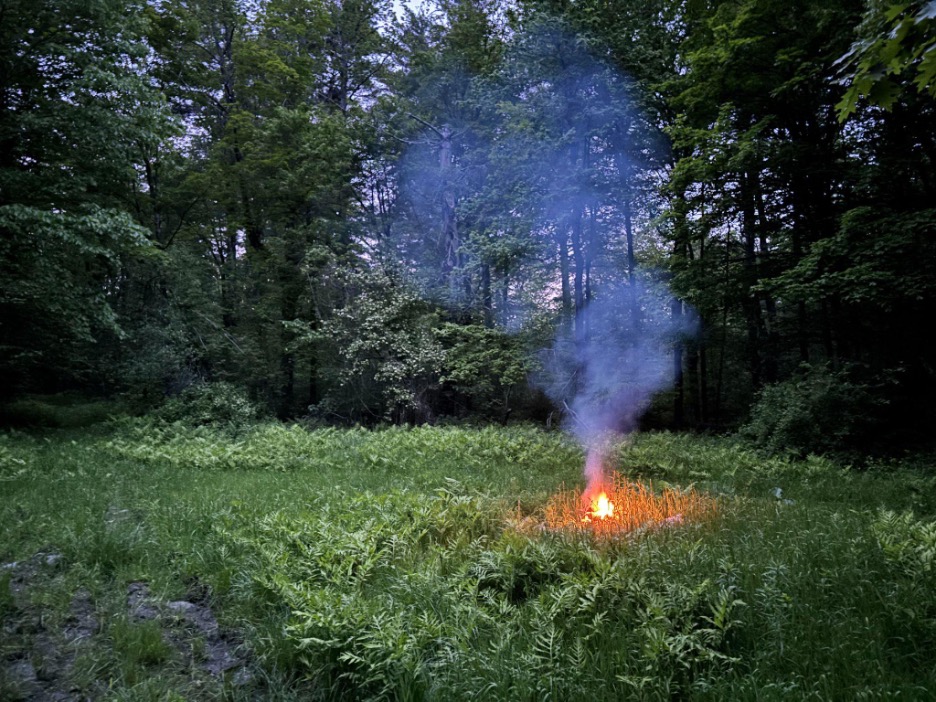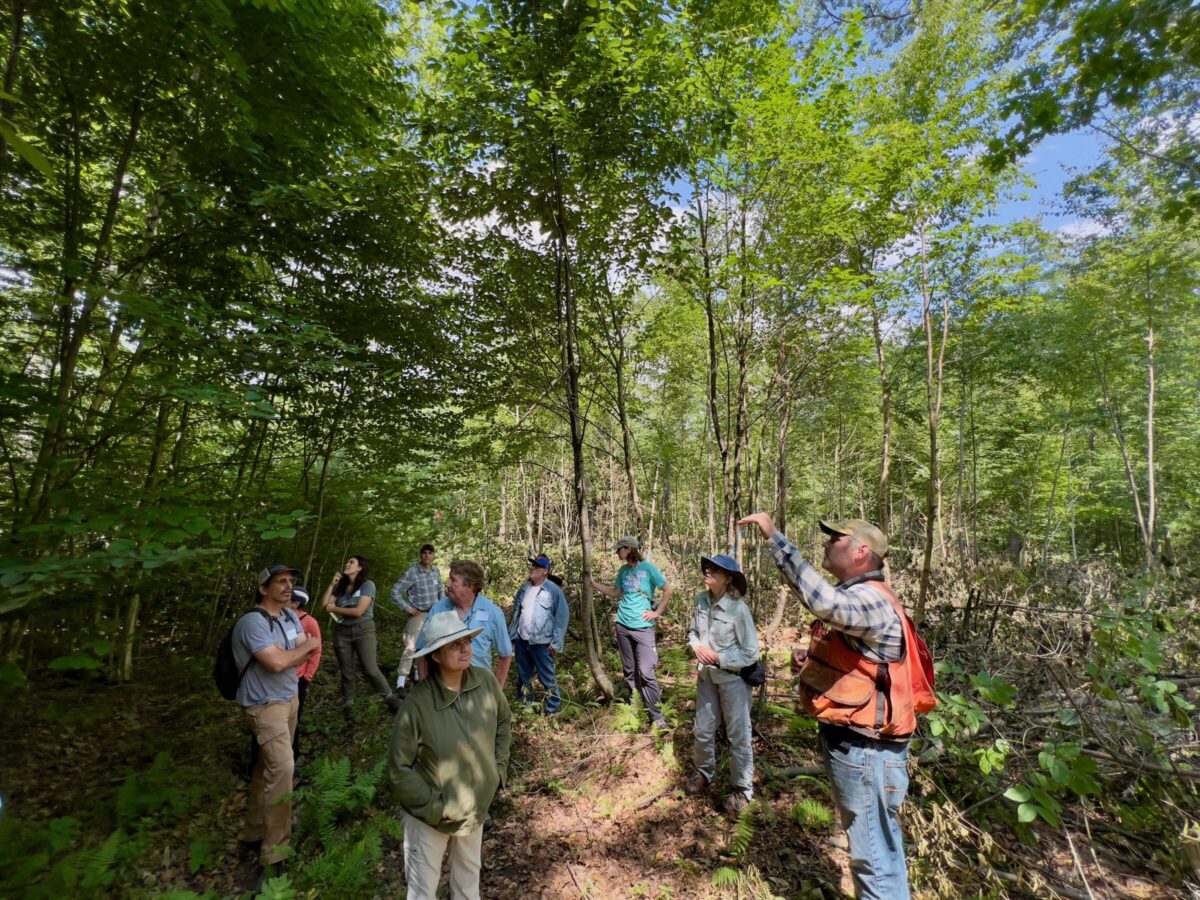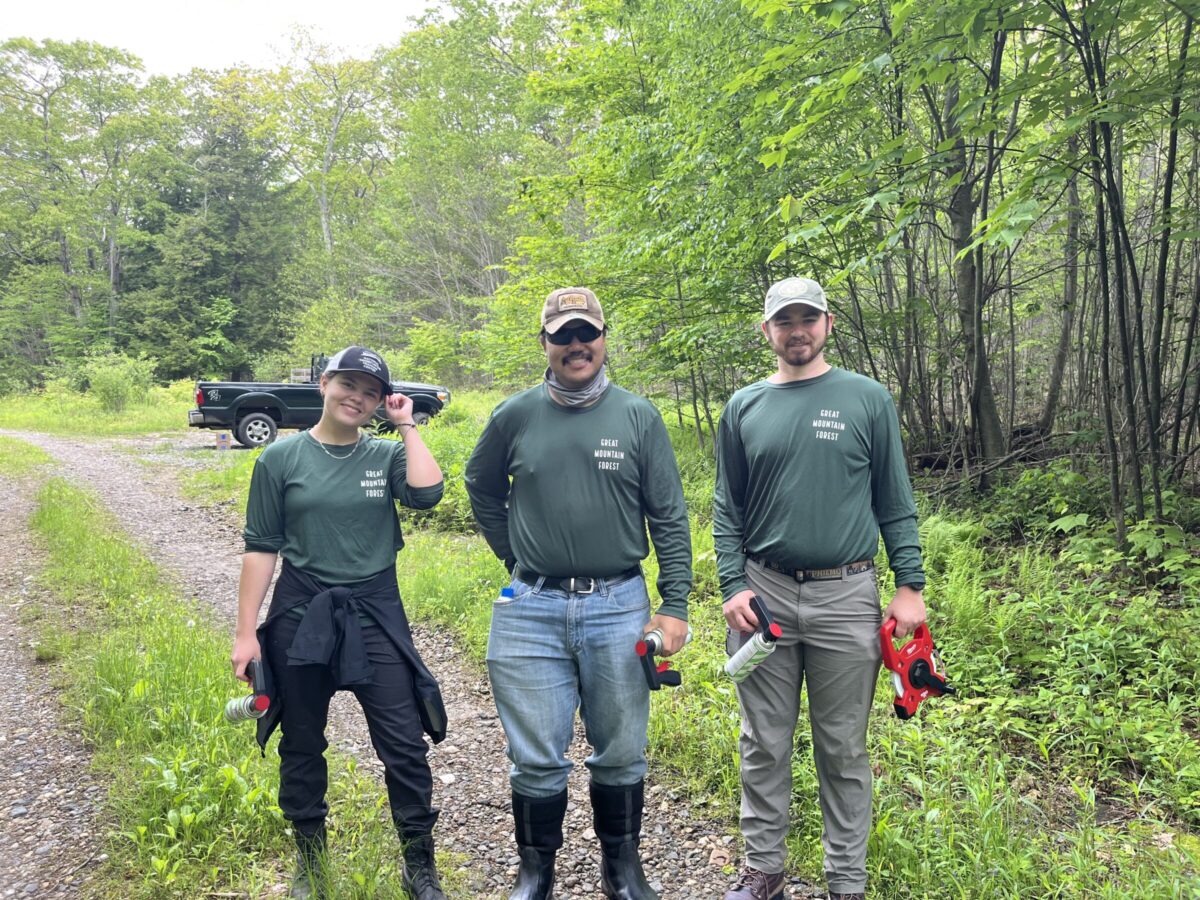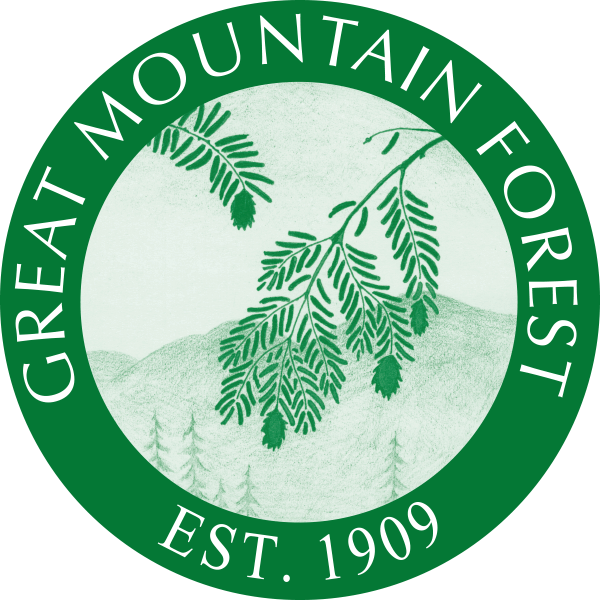
PREVIOUS WEATHER REPORTS
GMF’s Resident Moose are the Subject of Scientific and Photographic Study
Great Mountain Forest is home to 20 of Connecticut’s 100 or so moose. Yet most people who visit the forest will never spot one. That’s because despite their significant stature and status as New England’s largest land mammal, these ungainly ungulates—members of the order of hoofed mammals— move through the forest with remarkable stealth and agility.
Wildlife photographer Stephen Schumacher, however, who has been documenting GMF’s diverse fauna for eight years, has captured GMF’s resident moose on multiple occasions. And Ed Faison, senior ecologist at the Highstead Foundation, a regional conservation organization based in Redding, CT, has studied GMF moose to better understand how they impact temperate forests.
Under the Microscope
Faison, the lead author of a recent paper on the effect of moose and white-tailed deer in New England on forest regeneration, explains “Moose have been studied for decades in the boreal forest, in Canada and Scandinavia and Alaska. So a lot is known about what they do to forests up there, but very little is known about what’s going on down here [in the temperate forest].”
Moose are relative newcomers to Connecticut. In fact, there is no hard evidence to suggest that the species had a stable breeding population in the state until the 20th century.“GMF is a great study site because it’s one of the few spots in Connecticut with moose, it supports long-term research and is actively managed” explains Faison.
Faison along with Steve DeStefano from the United States Geological Survey Collaborative Wildlife Research Unit at the University of Massachusetts spent 15 years monitoring the browsing (foraging) habits of moose and deer to determine their impacts on the abundance and composition of a re-growing forest in a disturbed woodland site, such as an area that had been cleared for timber harvesting. GMF proved an ideal study site.
A moose that eats up to forty or fifty pounds of food per day can certainly produce notable effects on the reemergent trees. Faison and DeStafano found that rather than restrict the forest’s ability to regrow, as prior scholarship had suggested, browsing’s primary impact was to direct different plant species to succeed in the disturbed environment, without substantial sacrifices to overall biomass or biodiversity.
The study, Resilience and Alternative Successional Trajectories in Temperate Forests Exposed to Two Large Herbivores published in the journal Forest Ecology and Management in June, concluded that the moose and deer did not significantly impact forest resiliency, or its ability to regrow after disturbance.
However, the scientists also concluded that the moose and deer’s feeding habits did affect the forest’s composition. The browsed sites showed markedly reduced deciduous tree growth. That’s because the animals favored deciduous species, allowing white pine (Pinus strobus) to grow more abundantly in the browsed stands.
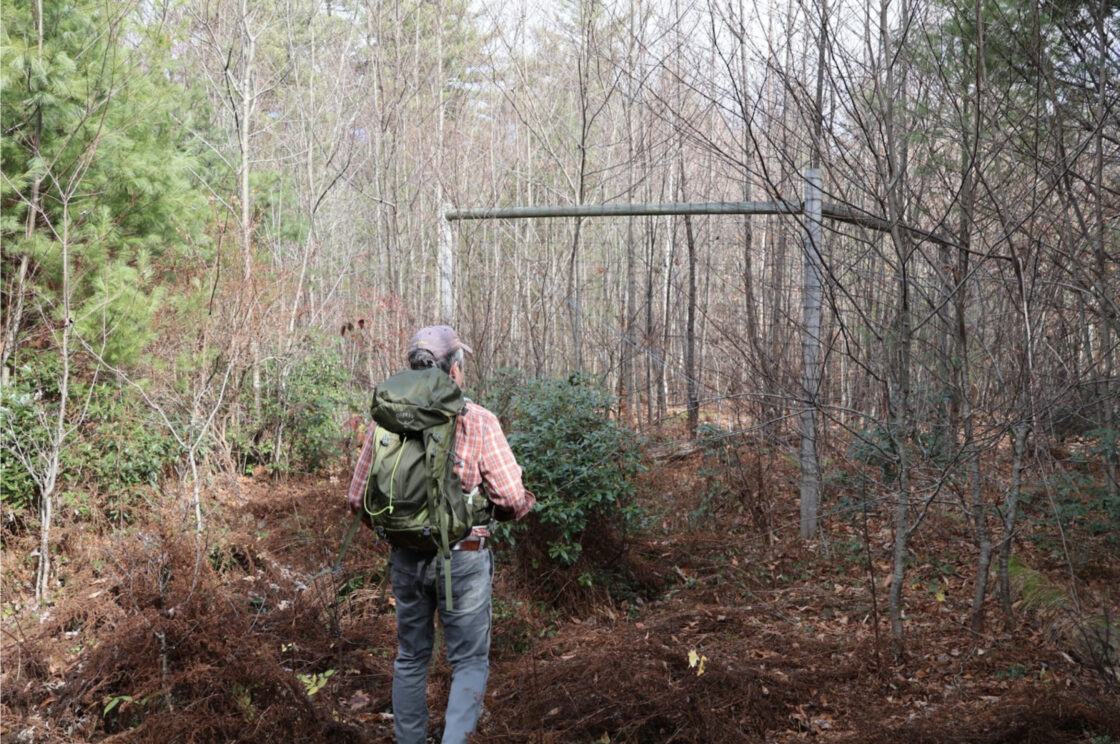
Faison inspects a partially enclosed plot that excludes moose but permits deer. Photo provided.
Through the Camera’s Lens
Rather than their impacts on the forest, wildlife photographer Stephen Schumacher is interested in documenting the animals themselves, which is no easy feat.
Despite being New England’s largest land mammal, moose are seldom seen. And even though their antlers can span up to five feet across, these ungainly looking, yet agile animals manage to negotiate the dense understory with remarkable ease.
“I’ve seen moose going through mountain laurel that is thicker than thick,” remarked Schumacher during a recent conversation. “It’s hard enough for me to get through there.”
Yet Schumacher persists. “This is a lifelong project,” he says. “I still want to get my quintessential moose in early morning or late afternoon sun getting lit up like a Christmas tree.”
Not only does their reticent nature make moose encounters a challenge. But a moose that feels threatened can kick, charge or stomp, particularly a cow protecting her calf.
Schumacher’s dogged pursuit of moose has meant he’s had his share of run-ins with the woodlands giants, and the pictures to prove it. On August 27 this year, while riding his bike, Schumacher spotted a looming shape emerging from the edge of the woods. Jumping off his bike, and struggling to keep his hands steady as he prepped his camera for the shot, Schumacher uttered a low guttural sound to draw the huge bull’s gaze.
Normally, the photographer wouldn’t vocalize to the animals, but since this was before rutting season, he said the bull was calm. “His ears were up… he wasn’t posturing with his antlers. He was relaxed.”
To Schumacher’s amazement, the bull offered a reply. “He turned his head broadside, and he looked back at me, and he answered me back.”
“It sent chills up my spine,” he continued, after a pause.
“Seeing that bull, that’s probably the coolest thing I’ll ever encounter. And I’ve been able to photograph wolves out in Yellowstone,” he said.
Schumacher has been tromping around GMF’s hinterlands for eight years, and he also monitors a number of trail cameras he set up around the forest, which gives him rare access to documenting moose as well as other mammals in the wild. Once, five years ago, two deer walked by one of his cameras and for a split second, the outline of their antlers matched perfectly. “Those guys were actually twins,” Schumacher said with a grin. Schumacher’s cameras have also captured fishers, martins, coyotes, foxes, bobcats, and “lots of bears—some giant bears.”
“I don’t take any of that for granted,” he said, emphasizing his gratitude to GMF staff for allowing him the access to do what he does. “It’s like getting a golden ticket in Willy Wonka.”
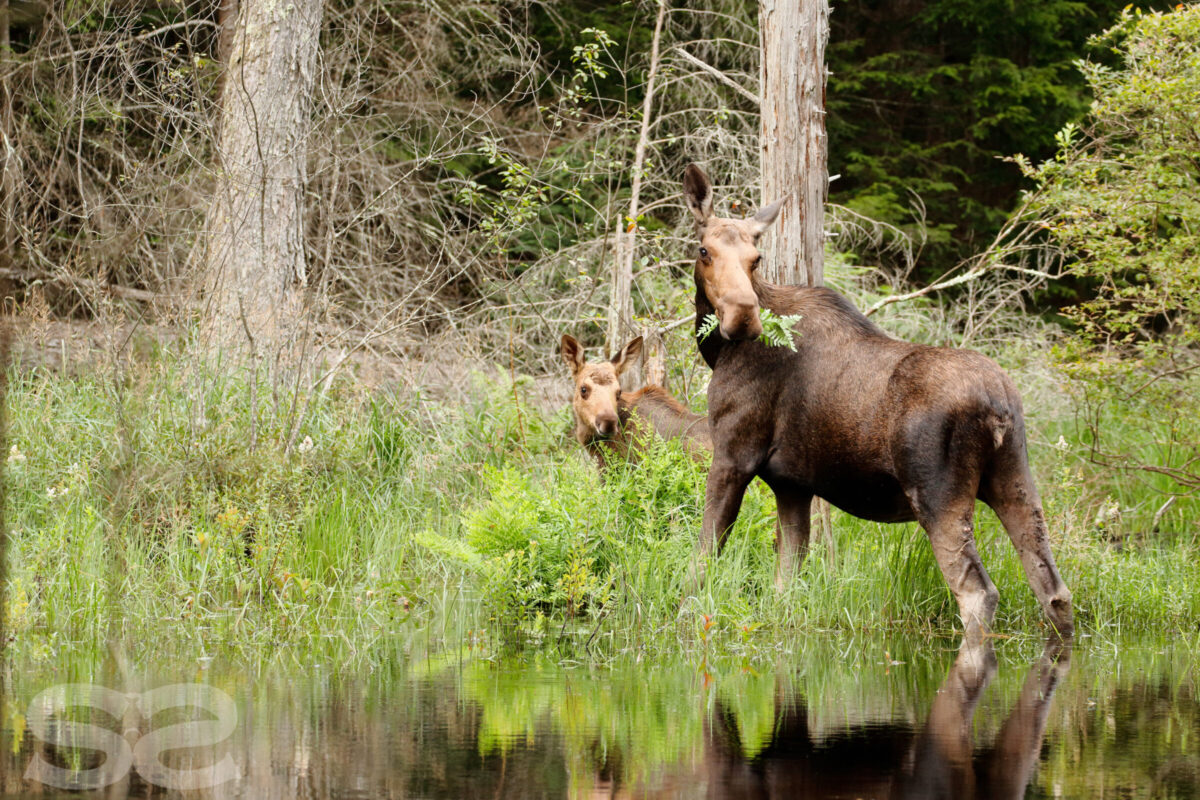
Despite his hands quaking with trepidation, Schumacher managed to capture a few images of a moose cow and her calf. Photo: Stephen Schumacher
Schumacher’s photographs and trail camera footage can be found on instagram @sds.wildlifeimages.
Misunderstood Asters: A conversation with Horticulturist Deb Munson
August has come and gone at last, the kids are back at school, and the forest floor is blanketed in white. While recent weather patterns have made anything seem possible, this is not the result of a historic Labor Day blizzard, but rather the on-schedule flowering of Eurybia divaricata, or, as it is commonly known, the white wood aster.
Expert horticulturalist, native plants advocate, and close GMF neighbor Deborah (Deb) Munson advises homeowners who see that snowy carpet abutting their yards at the forest’s edge to welcome the asters. They bring a host of late-season benefits to the garden and broader ecosystem alike.
“I think asters are very misunderstood,” said Deb in a recent interview, “which is unfortunate because they’re one of the greatest plants for pollinators and caterpillars,” second only in caterpillar hosting to fellow autumn-flowering goldenrod. The white wood aster is among the first of the New World asters to bloom in late August, and it has already brightened the dry and shady corners of Northwest Connecticut’s yards and woodlands.
If you’ve glanced out from your kitchen window in the past week, taken a recent stroll on one of GMF’s trails, or paid a long-weekend visit to your garden, chances are you’ve seen these late bloomers thriving under dappled sunlight, their individual stems mingling with their neighbors to create a veritable stronghold of delicate white blossoms.
The white wood aster’s ability to cover ground so extensively can alarm home gardeners and yard keepers who may find them to be “messy and weedy,” Deb said, but she assured that they provide a wealth of services.
That ability to provide a herbaceous groundcover is actually one of the aster’s greatest assets, she explained. “I believe in plants sort of being their own mulch,” Deb said, and the white wood aster can provide a perfect “carpet” in shadier portions of one’s garden or at the fringe where the yard meets the forest. She explained they flourish in the “ecotone” area at the woodland edge, or under a canopy that provides dappled shade.
Letting the garden, yard, or woodland mulch itself with understory plants and autumn leaf fall keeps the ecosystem contained, protecting against diseases or invasive species that could be brought in by an external material. Plus, it’s cost effective: “you pay people to take your debris away, and then you pay them to bring in mulch.” Deb suggested it’s cheaper, simpler, and safer to let the plants do the heavy lifting for you.
Plus, they’re self-sufficient. As they self-sow and are generally hardy, they require little maintenance. In Deb’s words: “They’re pretty carefree.”
Deb pointed out that like many other native fall-blooming wildflowers, they are drought-tolerant, unlike lots of non-native species that are sold at garden centers: “Native plants are adapted to our region, and they have more resiliency… I feel like it’s pretty dry right now, but it doesn’t seem like the asters are skipping a beat.” As erratic weather patterns, including droughts, persist, species that are able to withstand dry weather will continue to provide vital ecosystem functions and also, in the case of garden and yard populations, save water for homeowners.
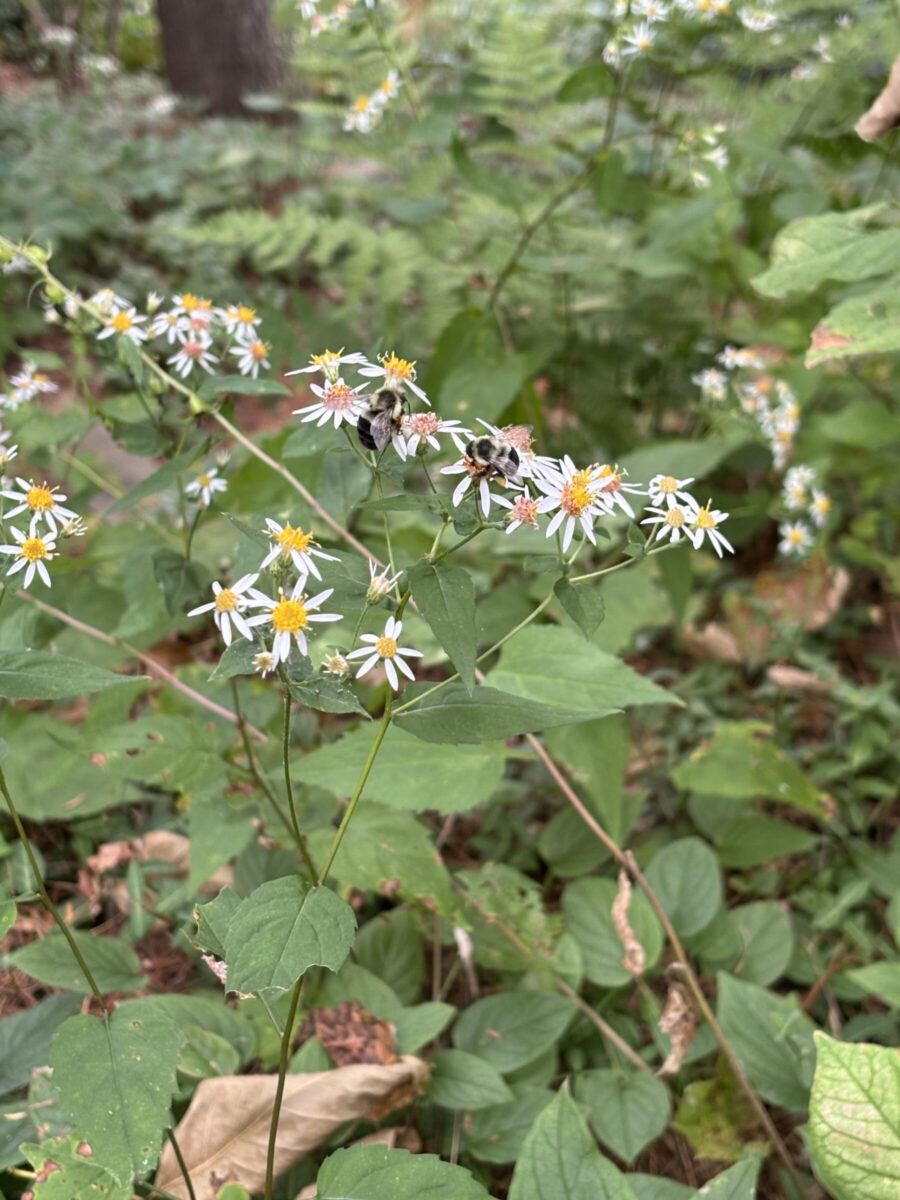
Photo by Alec Linden
And finally, aesthetics matter – as Deb put it, “they’re beautiful.” Since they are plants that flower in autumn, their comparatively humble springtime appearance of green, serrated foliage may entice many gardeners to pull them prematurely, unaware of the decorative potential in just a few months when the most glamorous spring ephemerals have long since shed their petals. Their good looks serve an ecological purpose too, bringing in bees, butterflies, and other late-season pollinators whose options for a meal are dwindling.
“If you’re not too tidy and antiseptic about your woodland edges, you could have an amazing display of asters and goldenrod,” Deb said, among other misunderstood yard-dwellers such as white snakeroot (Ageratina altissima). “I look out on my woodland edge, right off my porch, and I’m looking at goldenrod and aster divaricata (Eurybia divaricata), the white wood aster, and there’s Symphyotrichum cordifolium there.”
Deb advised the curious to keep their eyes peeled for a number of other fall flowering perennials just starting to show their colors: the deep purple New England Aster (Symphyotrichum novae-angliae), the flat-topped aster (Doellingeria umbellata), and the smooth aster (Symphyotrichum laeve), in addition to many others.
Deb said that she feels American landscaping aesthetics have erred too far in the direction of the sterile, and that she encourages homeowners and land managers in the Northwest Corner to embrace a “wilder” sensibility in their gardens and properties. Not only does welcoming fall wildflowers bring a jolt of color to one’s yard as the days ruthlessly shorten, but it establishes a communion between the home and the broader ecosystem that has largely eroded in much of modern Western life.
“I think learning your land is an important thing to do,” Deb said, and she has the resources for those looking to get started. For field guides, she recommends Lawrence Newcomb’s Wildflower Guide and Ted Elliman & New England Wild Flower Society’s Wildflowers of new England. She also suggests two introductory guides on local native plants: Native Plants for New England Gardens by Mark Richardson and Dan Jaffe and The Northeast Native Plant Primer by Uli Lorimer.
For those looking to chat directly to expert gardeners or start preparing for their own native plant garden, Deb has a list of local nurseries specializing in wild plants to check out: Lindera in Falls Village, the Native Plant Trust’s nursery Nasami Farm in Whately, Massachusetts, Earth Tones Native Plants Nursery in Southbury, Connecticut, and Helia Native Nursery in West Stockbridge, Massachusetts.
Reflections from Meekertown – 24 hours alone in the forest
In late May, in my role as GMF Newsletter Editor, I had the opportunity to spend the night at the Meekertown Cabin, a rustic but cozy outpost on the site of a onetime homestead at the southwestern extremity of this 6,300 acre forest. The objective was to produce the article you now read; whatever happened between embarking and inscribing was up to me.
In Connecticut, our forests are many, but they are crosshatched by private property, highways, and development. For all its rural charm, the fourth most densely populated state in the country offers little in the way of true wilderness. For those of us in the Northwest Corner, though, Great Mountain Forest (GMF) gives us something pretty close.
The following report is an account of a night spent alone in some of Connecticut’s deepest woodlands, with the only goal being that I allowed myself to be led by the experience instead of following a pre-planned agenda. When we’re alone in the woods, who leads us? And where do we go?
Setting out
GMF Property Manager Russell Russ picked me up on a sunny afternoon and ferried me from the East Gate entrance along the well-maintained Camp Road, onto Chattleton Road, and to the West Gate on Canaan Mountain Road.
Along the way, Russell identified the complex human interventions on the landscape that make it what it is today. Russell essentially grew up in these woods, his father Darrell being a longtime forester manager at GMF who, throughout the 20th century, essentially shaped the forest we see today alongside forester and owner Ted Childs. He pointed out a stone dam below Old Man McMullen Pond with an ancient outlet pipe, below which sits the subtle remnants of an old saw mill, once one of the major vocations of this now uninhabited stretch of highland forest. Further along, Russell explained that the stands of non-native conifers that hemmed the road had been planted as an arboretum for exotic evergreens.
As much time as Russel has spent in the forest, he was quite visibly surprised by the sight of a cow moose, grazing languidly on the Big Island of Old Man McMullen Pond, which we spotted from the window of his truck. With wide eyes, Russell said that in two and a half decades working full-time in the forest, it was the first time he’d seen a moose at this pond. While we watched, a beaver cut a clean V in the still black water just in front of the moose enjoying a leisurely lunch.

The best photo of the moose we managed, just barely within zoom range.
After exiting the forest, 15 more minutes brought us down the slopes of Canaan Mountain, out onto Route 63, and eventually onto North Goshen Road, where the chauffeured portion of my journey abruptly ended. Russell handed me a stack of paper maps, some parting bits of advice, and peeled off back to civilization.
My guides:
The ferryman
Buzzing with the anticipation of 24 hours of solitude in an unfamiliar place, I felt like Odysseus, ferried by Charon across the River Styx, even though the TV-sized display screen of his new Toyota Tacoma blared in front of my face. Russell was conveying me to an unknown frontier, depositing me at the forest’s wild southern boundary. He imparted the knowledge that would enable me to find my way through the tangle and keep me on the known path without getting lost.
But getting a little lost, of course, was part of the plan. Searching for Russell’s landmarks – the Collier’s Cliffs overlook, Pothole Falls, and several other remote curiosities of the wild Meekertown area – brought me on bushwhacking missions. I etched through thick undergrowth and scrambled up the slick bedrock exposed by the rush of Brown Brook’s cascades in a gambit to rediscover Meekertown Road, which I’d left behind some time before. Halfway up, I paused for a dip into a rust-colored pool as the light faded from the understory, and felt wonderfully a part of the darkening forest around me.
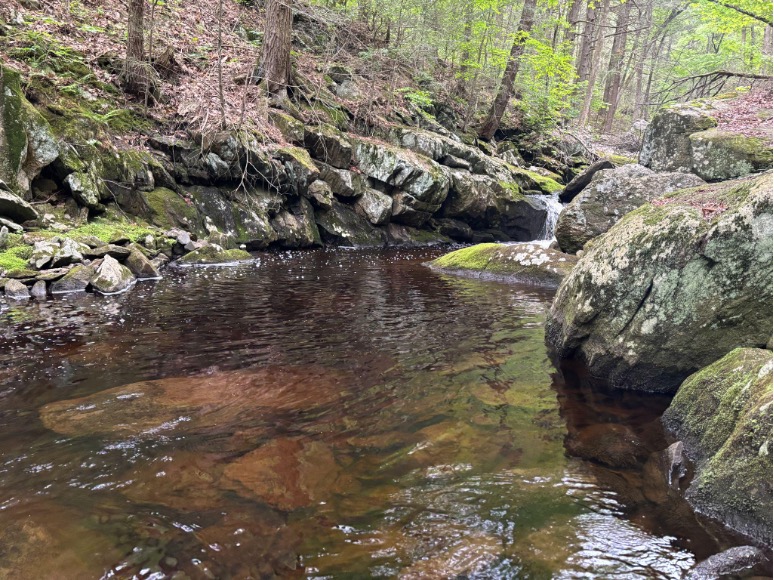
The grotto-like, rust-colored pool somewhere on Brown Brook
The bears, beavers, and beyond
I followed Russell’s directions up the verdant road until I crossed a bridge that brought me back into GMF territory and up a trail that would eventually intersect with the historic Meekertown Road near Wampee Pond. I began to spot mounds of bear droppings, a day or two old – a signpost of another type of guide in the forest.
These roads, though grown over and seldom used today, were once the conduits for thriving industry in these hills. Their legacy as thoroughfares is carried on today by the animals who have returned to habitats once wrested from them by the enterprises that built the roads.
As I arrived at Wampee Pond, taking in its boreal affect, a northern water snake cut s-shapes across the still, ink-black surface while two beavers busily reinforced a dam at an outflow of the aptly-named Brown Brook, which runs dark with the tannins of organic detritus steeping in its cold waters.
I tried to channel the animals’ movements across the landscape as guidance for my own. When multi-stemmed, heavily branched fallen trees blocked the overgrown corridor of the lower Meekertown Road, I followed the dim impression of deer tracks, to navigate the blockages obstructing my path.
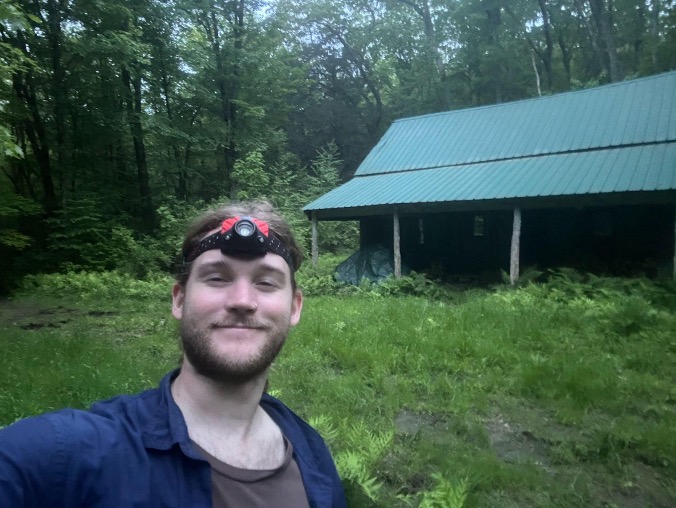
The author settling in for the evening at Meekertown Cabin
The colliers
That these animals are able to flourish – even impose their own will – upon a landscape once denuded by 19th century industrialism is remarkable. “It was a wasteland,” said former GMF director Hans Carlson on a recent phone call, emphasizing that resilience and resurgence are core aspects of GMF’s forest history. The now-verdant hills were stripped of vegetation to fuel the colliers’ fires, and the hollows subsumed by miasmas churning from charcoal hearths and pig iron blast furnaces.
When the colliers tended their fires here, there would have been no bears sharing the roads, no beavers laboring in Wampee Pond (which didn’t exist – it was dammed in the early 20th century as waterfowl habitat and forest fire protection). Traces of their hearths are found throughout the forest, and the Meekertown area would have been sporadically populated by these solitary, hardened men who were likely haunted by their desolated landscape.
There are lurid stories of murder and mischief whispered about the past inhabitants of Meekertown. In 1820, a clergyman described the settlement as a “hamlet of heathens, living in intellectual, moral, and spiritual darkness,” which GMF recently immortalized in a series of t-shirts and is also referenced in the name of a beer brewed by nearby Norbrook Brewery called “Hamlet of Heathens,” brewed with wild Meekertown-foraged hops.
While this reputation may have had some credence, the truth is that they were opportunistic, and maybe a little introverted, individuals who made their way in a difficult world. In any case, their stories, and the remnants of their hearths and shanties left behind, animate the landscape with a colder, more imperfectly human history entangled with the vibrancy of the forest that flourishes today.
Meekertown Road is split in two, where Brown Brook burbles over the long-collapsed remnants of a bridge before it cascades to the valley floor below. While I sat in that spot, listening to the tea-stained water rush over the rocks, the occasional roar of a semitruck from Route 63 broke through my reverie. GMF, as wild as it feels today, is still susceptible to industrial intrusions from time to time.
While the colliers may have not been focused on the trees and birds like many of our modern forest goers, they were certainly attuned to their fires. I meant to avoid cosplaying collier during my overnight stay at the cabin, but as evening fell I found myself tending to a smoldering blaze in the clearing just outside the building.
It’s difficult to imagine the life of a collier, staring intently at a pile of timber and earth for weeks on end, measuring its interior heat by the color of the smoke that rose from the mound. There would have been none of the hooting barred owls or rustle of the breeze in the treetops then. I have a note in my journal that I must have scribbled out there: “It’s amazing how long you can watch fire. It’s almost difficult to do anything else.”
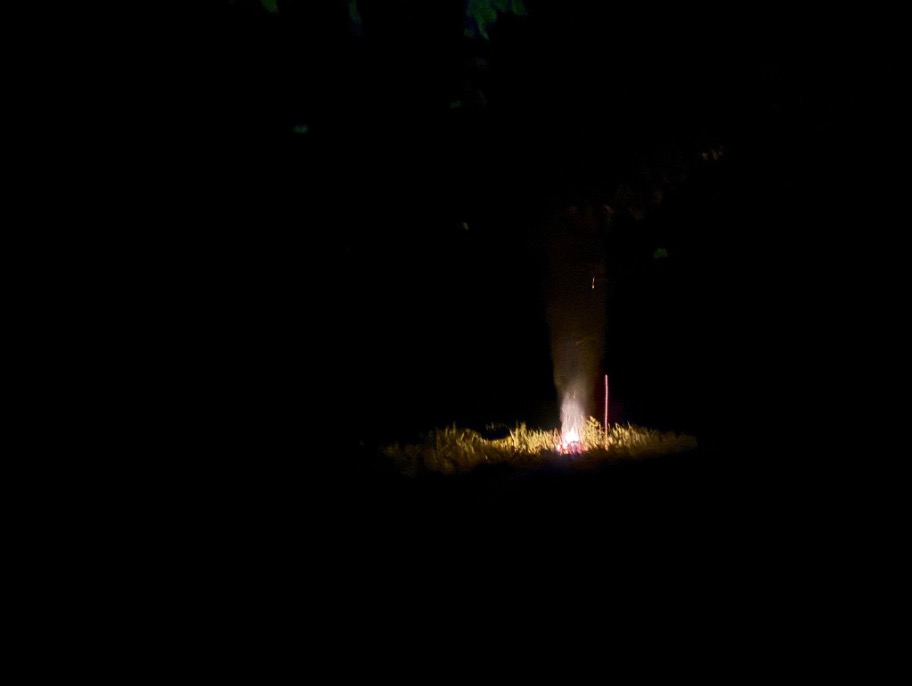
The storyteller
I woke the next morning on the wooden floor of the cabin, the beaming sunshine illuminating the many inscriptions etched into the walls from the scout troops, artists, and hunters who had previously taken refuge within its walls. The two rocking chairs which face the formidable hearth at the front of the room sat eerily still as dust motes fluttered in the sunbeams.
“Don’t sit in Mrs. Dean’s rocking chair!” GMF trustee and forester Star Childs had told me the day before with a mischievous grin. “If it starts rocking, get outta there.” Luckily, nothing moved during my short stay – that I saw, at least.
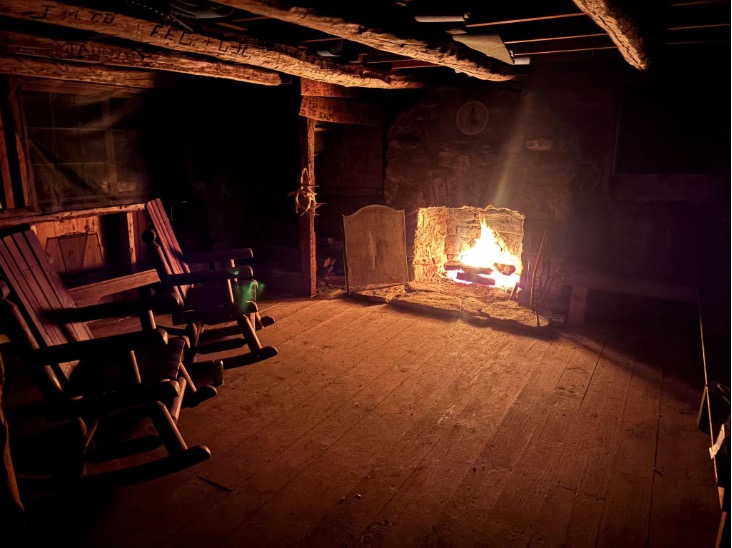
Which one is Mrs. Dean’s?
Having my route back to the East Gate more or less mapped out, I contemplated backtracking east on Meekertown Road a little bit to search for the gravesite of several onetime residents. The late environmentalist and poet David Leff wrote rhapsodically about GMF’s landscape, its tenacity and will to survive, and he described its former inhabitants with the same reverence.
“Meekertown’s ghosts are never frightened,” he wrote in a yet-unpublished paean to the forest. “Their tales linger.” On his own visit to the graves, Leff reflected somberly on their memory: “We show our respect by quietly keeping the stories alive, as best we can.”
Leff’s writing guided me to try and see the forest as he did – as a patchwork of animations and presences, each contingent upon the other. Leff showed that GMF is constituted by the stories that dwell in the minds of the foresters who have spent their lives within it, and the memory of those who made homes and lost them here, just as much as it is by its trees, hills, and hollows.
Having fulfilled my bushwhacking quota the previous evening tromping around Meekertown, I decided to let the graves lie. And anyways, as presumably solitary individuals in life, maybe they appreciate their alone time in death too.
A guide for the reader
With that decision made, I turned left onto GMF’s north-south arterial, the refreshingly obvious and debris-free Number 4 Trail, and began my journey home. What follows here is my attempt to pay it forward: as I was guided through my time in the forest, perhaps this suggested route – which I can confirm is well worth it – will inspire the intrepid rambler to undertake their own journey from GMF’s wild southern reaches to the East Gate Campus..
As a disclaimer, any distances given are estimations, and anyone wishing to walk these trails should consult a map, available on the GMF website.
Find your way to the intersection of Meekertown Road with the Number 4 Trail. Getting to this point means either hiking in on route of your choosing, or devising another creative access plan. For a detour to the Meekertown Cabin, follow Meekertown Road west about a half mile to a clearing where the cabin is easily seen, then turn around and head back to the junction. For those who want to skip the cabin, start heading north on the Number 4 Trail with Wampee Pond to the right. Make sure to spend a minute searching the surface for disturbances from snakes or busy beavers.
Continue up the Number 4 Trail for another 2/3 of a mile or so before coming to a small clearing on the left after a bit of an incline. At the back of this clearing, an obvious but small trail leads to the best view I’ve seen so far in the forest: Wapato Lookout.
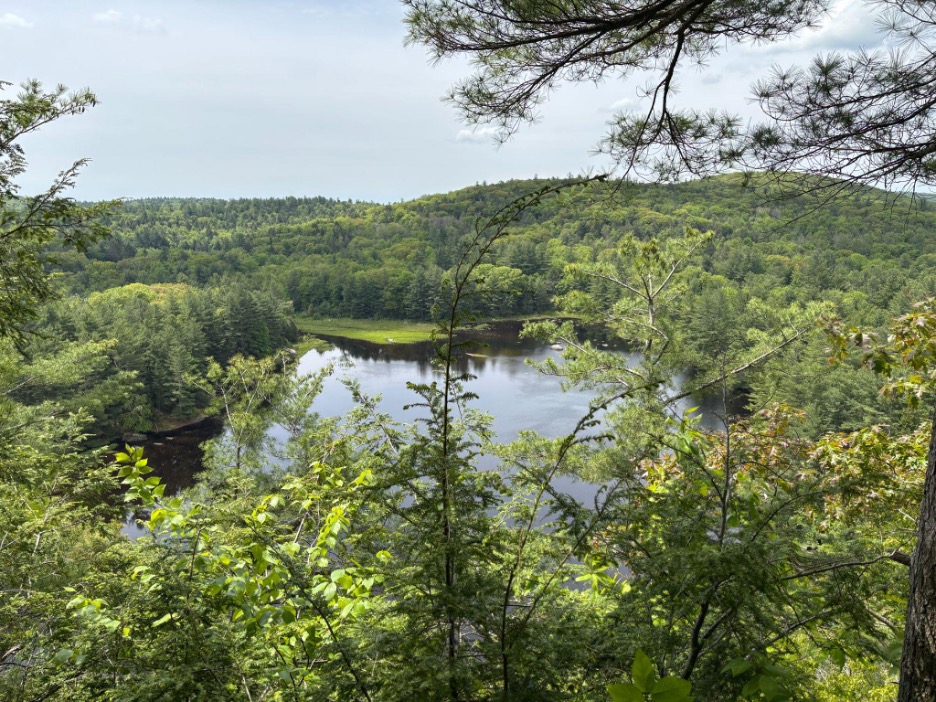
The view. It’s even better in person.
From a dramatic precipice, the view extends through a white pine-framed window over the black waters of Wapato Pond and rolling peaks beyond, exemplary of the adage that GMF often feels more like New Hampshire’s deep woods than southern New England. I spent a good 45 minutes here, swatting mosquitos and enjoying a respite on the bouncy, needle-strewn soil. It’s the type of spot one could spend quite a bit more time at with the right schedule.
Heading back to the Number 4 Trail, continue north for a little over a mile through varied woodlands until the Sam Yankee Trail peels off to the left. Follow it for a few hundred yards, until a well-marked sign points left to the Matterhorn. Enjoy the short but stimulating climb to the rocky precipice in the heart of GMF, with nothing but rolling woodlands around you. Enjoy your lunch here, and be careful with the lichens.
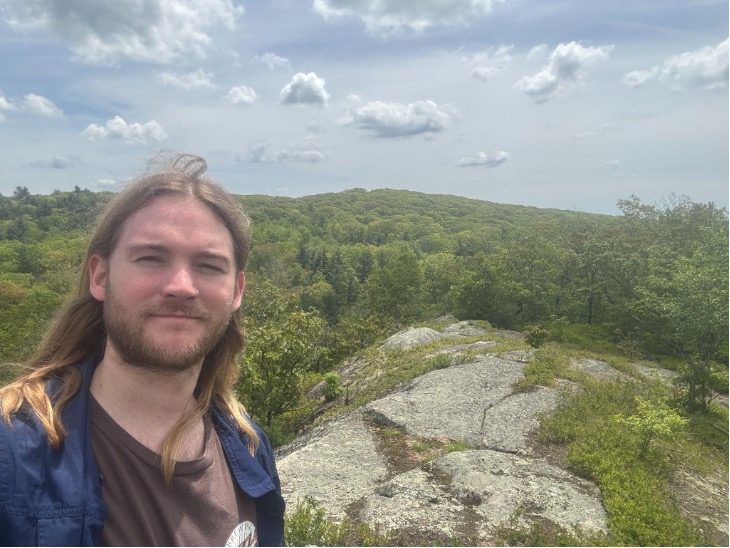
The author, post-lunch and perched on the Matterhorn
Backtrack to the trusty Number 4 Trail, and continue heading north. After another mile or so, turn right, rounding a gate onto the Crissey Trail, where a mystical forest of hemlock and slim maples towers above a formidable network of low stone walls.
After a while, turn left onto the shady and boulder-strewn Crossover Trail. If inclined, take a detour to the Crissey Pond overlook for another fabulous view. Head back to the Crissey Trail and continue on to GMF’s famed glacial erratics, large boulders dropped during the retreat of the Laurentide Ice Sheet. As a rock climber, I found myself atop one of them, hanging out with a ruby-throated hummingbird on a bed of ferns and moss.
The Crossover Trail spills out to the Camp Road, where one can head back to the East Gate through a corridor of hemlocks and yellow birches for another taste of the north country, making sure to stop at the model charcoal pile exhibit demonstrates the complexity of charcoal fires.
My iPhone clocked the total mileage, with all the detours, to be between seven and eight miles. For those who want more, a spur loop to visit the prehistoric Tobey Bog can be achieved via the Overlook Trail, Charcoal Pit Trail, and Tobey Bog Trail.
Happy hiking!
Future Forests in the Making: Climate-Smart Thinning at Great Mountain Forest
As New England experiences increasingly extreme weather, including hotter and wetter summers, keeping forests healthy and resilient to pests and disease is an ongoing challenge. Work has begun implementing Connecticut Land Conservation Council’s (CLCC) Climate Smart Land Stewardship Grant at GMF! Great Mountain Forest recently began a pre-commercial thinning project, which is a forest management practice that involves removing trees from a young, dense stand before they reach a size where they can be commercially harvested.
Managing Competition
In areas at GMF where trees were harvested 20 years ago, young trees have grown back fiercely, racing to become the future forest. Most of these new trees will end up being shaded out underneath their stronger brethren or succumbing to damage or disease. By applying management methods that support a diversity of tree and animal species and provide more resilience to pests and other disturbances, our foresters are controlling that competition to enhance traits we hope to promote.
We start by marking a “pre-commercial thinning,” or PCT, in three stands that are approximately 20 years old. “Thinning” means removing the trees that are competing with those we want to keep strong and healthy. “Pre-commercial” means that we are implementing this treatment when the trees are too small to be sold as wood products, which is where funding directed by CLCC comes in to support this work. We chose trees spaced on average 10 feet from one another, giving them the light they need to grow quickly when they are “released” from competition by this treatment.
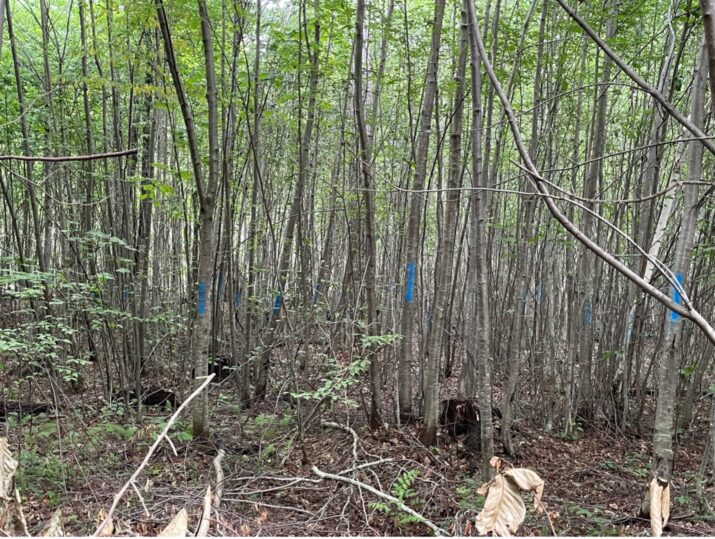
Stand marked before treatment (note very high density of stems).
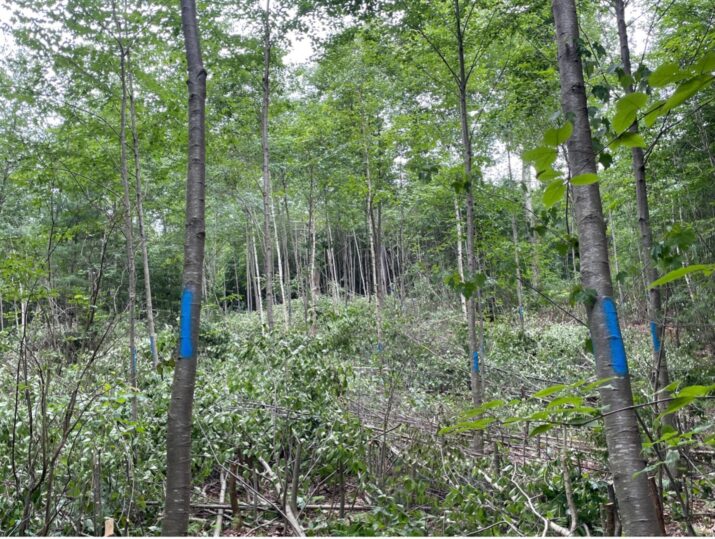
Stand after thinning treatment (only marked individuals remain standing).
Shaping the Future Forest
In selecting which trees to keep, there are a few things we keep in mind. The first is health and form. We choose trees that are going to last: those that aren’t suffering from disease, that have stable trunks and full crowns, and that have no obvious wounds.
Unfortunately, we have to remove most of the beech in these young stands. American Beech, or Fagus Grandifolia, is currently under a dual attack from beech leaf disease and beech bark disease. Nearly all of the beech in our forest are succumbing to one or both of these diseases. While we save any individuals that seem to display resistance, we know we cannot count on the majority of them as our future canopy.
The other factor we consider is species composition. Presently, these stands are almost entirely beech and black birch (Betula lenta). We therefore want to promote the other species within the stand to make it as diverse as we can. Tulip poplar, white, yellow and grey birch, ash, cottonwood, and oak are growing in these stands too, and we select for them to prevent the stands from becoming near-monocultures of black birch. While there’s nothing wrong with black birch, aiming for as much diversity as possible helps to increase stand resilience and support additional non-tree species in the forest. We’re also making sure to leave species like serviceberry and highbush blueberry. While these species won’t be our canopy trees, the fruits they produce are important food sources for birds.
Looking below the canopy, the effects of this treatment will also be seen on the forest floor. In this stage of competition, the amount of light that can reach the ground is quite limited. The trees are so densely packed that nearly nothing can grow beneath them. But by thinning the trees, we are allowing that light back in.
Forester Emeritus Jody Bronson inspired this project through his implementation of a similar PCT on a smaller scale over many years. What he saw after thinning was an understory full of not only herbaceous plants, but a new cohort of tree seedlings, particularly oaks, a group of species that has wonderful ecological value but can be difficult to regenerate. Now, should an ice storm come through and knock out the canopy trees, that young cohort is waiting in the wings to take off and swiftly become a forest again instead of having to compete for establishment.
Great Mountain Forest’s 2025 summer interns got to mark this treatment, selecting which trees to cut and which to leave. From the first week, they started thinking like foresters, making decisions that they would not see the full effects of for decades.
We are so grateful to CLCC for funding this work, which has provided young foresters with unique learning opportunities, added resilience to our forest, and created an excellent demonstration of sustainable forest stewardship.
Funding for this project was paid for by the Climate Smart Farming: Agriculture and Forestry Grant. Funding awarded and administered by the Connecticut Department of Agriculture and the Connecticut Land Conservation Council.
GMF’s 77th Cohort of Forestry Interns
Ren Cattafe
Hello! My name is Ren Cattafe, and I am an undergraduate student at UMass Amherst studying forest ecology and conservation. I grew up in eastern Massachusetts, spending a lot of time in forests, which fostered my love of nature early on and influenced my decision to pursue a career in natural resources. I’m interested in sustainable logging practices, promoting forest resilience through silviculture, and increasing community accessibility and knowledge of forested areas. During my studies I have also had the opportunity to participate in active hemlock woolly adelgid research, which I plan to continue in the coming academic year.
I feel extremely grateful to be working with GMF this summer. Not only has it been an incredible learning opportunity, but a chance to do work that serves a real purpose.
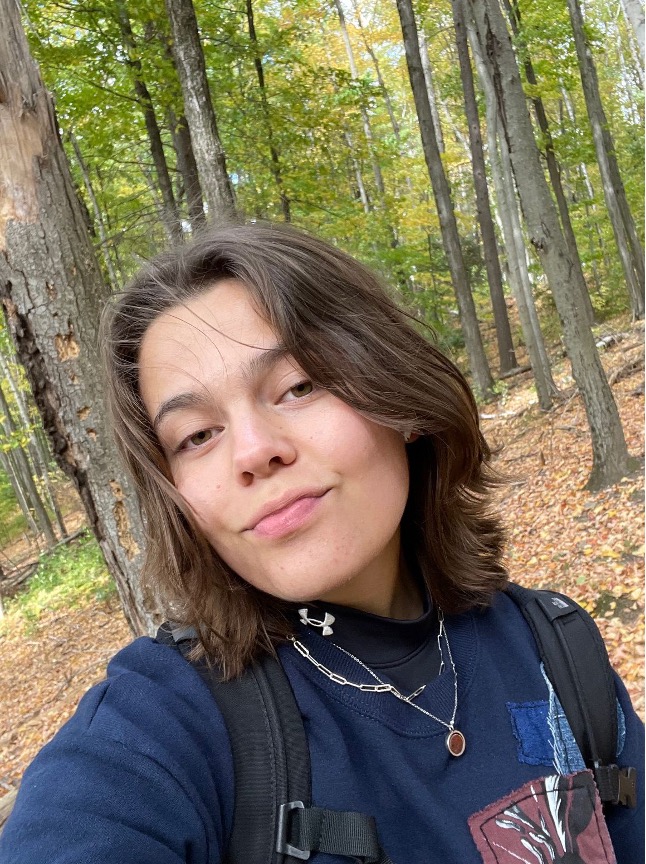
Within the first week, my fellow interns and I supported research that involved marking 30+ acres of trees with the goal of strengthening the dominant cohort and the understory. This experience has enhanced my ability to perceive and interpret forested landscapes in a manner that can’t be achieved in a classroom setting. I am thrilled that such research is supported here, and that both industry and science can coexist within the same space.
Will Watkins
Hello, my name is Will Watkins. I am a rising senior at North Carolina State University studying forest management with a concentration in ecology and a minor in environmental education. I first got into forestry as a degree because I grew up participating in boy scouts and spent a lot of time outdoors. The summer before I started my freshman year at college I was able to go on a special backpacking trip out in New Mexico where I learned about and helped with some forestry and conservation efforts. This inspired me to pursue forestry at school. Now that I have had some schooling and this internship, I know I made the right choice.
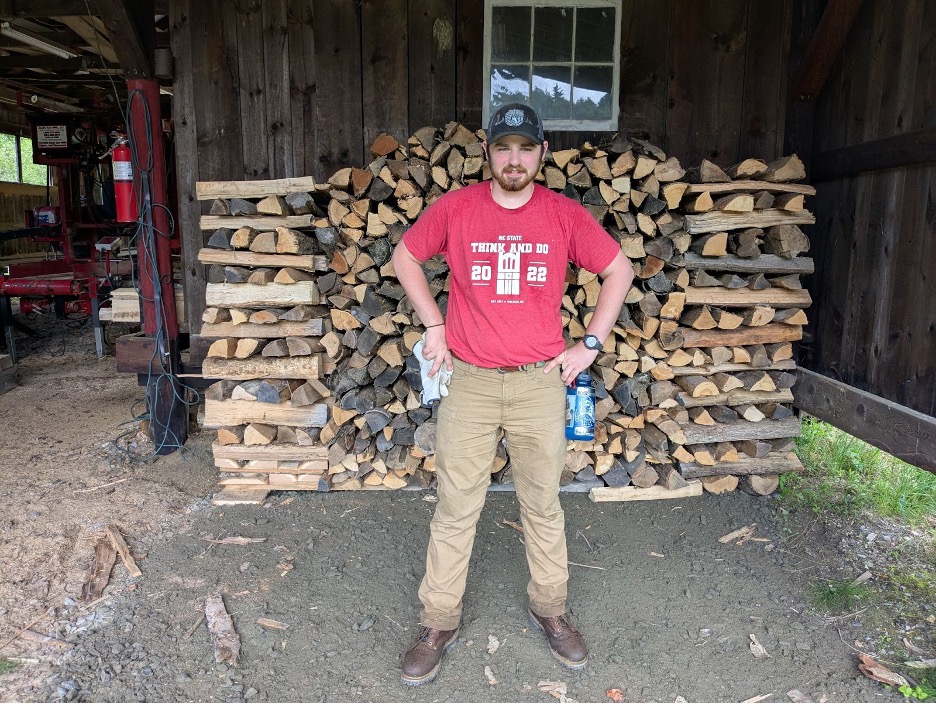
I was born and raised in North Carolina and had never heard of Great Mountain Forest, nor did I know much about the northwest corner of Connecticut. But as soon as I ran across this opportunity online I was excited and applied immediately. It checked all my boxes, plus it was in a part of the country that I have never been to? That’s great! Even now, after working here for a month, I am still slowly learning more about both GMF and the area.
So far, we have marked stands of trees for a pre-commercial thinning and we have made some plots in a stand of barberry to get an inventory of the understory. That is only a small bit of what we have done so far and what we will eventually get to do later in the summer. I am very much looking forward to the rest of the summer.
Ronald Law
Hello, my name is Ronald Law, and I am a 2025 summer intern at Great Mountain Forest. My interest in forestry began quite late in life as I was originally studying computer science. After some time however, my disinterest in the field became apparent to me and I decided I had to quit.

Six months later, I started working at a lawn care company, eventually becoming a tree and shrub specialist. Though I enjoyed my time there, I slowly came to realize the elements in our environment that were changing dramatically, resulting in the death and weakening of numerous plants under my care. As unusually warm winters became the norm, and invasive pests became more prevalent, I realized I wanted to work in a position that was more proactive than reactive when it came to the health of our environment. So I decided to return to school and pursue environmental studies, which eventually led me to my internship at Great Mountain Forest.
An afternoon in the Pleistocene

Peeking around the berry bushes into the Tobey Bog’s central clearing
The oft-maligned swamp, despite holding a persistent legacy in the cultural imagination as a place of decay with little utility or aesthetic appeal to humans, has garnered several famous fans over the years. The animated ogre Shrek, famed for his protectiveness over his marshy homeland, comes to mind as a recent example, though bogs have another, arguably more eloquent devotee: Henry David Thoreau.
“Yes, though you may think me perverse, if it were proposed to me to dwell in the neighborhood of the most beautiful garden that ever human art contrived, or else of a Dismal Swamp, I should certainly decide for the swamp,” the Transcendentalist thinker wrote in his 1851 treatise to wildness, “Walking.” In that lecture, Thoreau waxed poetic about replacing his cultivated front yard with “a few square rods of impermeable and unfathomable bog,” romanticizing the rawness of the bog in comparison to the orderliness of human landscaping.
Before I embarked on an afternoon visit to the bog on a gorgeous day in early June, GMF trustee, forester, and founding member Star Childs told me that he’s always identified with that particular fantasy of Thoreau’s. In fact, he’s been lucky enough to have lived much of his life with a swamp in his figurative front yard – namely, Tobey Bog in the “North Forty” region of GMF.
Tobey Bog is no ordinary wetland, at least not in Connecticut. In his as-yet unpublished paean to the forest, the late naturalist-poet David Leff, whose lifelong love affair with the GMF landscape began with an encounter with the bog, described it as “a subarctic fragment stranded about as far south as possible,” and, “a world unto itself where the usual ecological rules did not apply.”

A glimpse of Tobey Pond from beneath the hemlocks
Paddling out
Aided by the convenience of a canoe (courtesy of the Childs family), I took advantage of some rare good weather to ferry myself across Tobey Pond for my first visit to the bog. Paddling across the pond’s dark, serene waters, fringed by drooping hemlock boughs and tall stands of white pine, the experience felt more North Country than southern New England.
Tobey Pond, like the bog with which it shares a namesake, is a specter of the ice which once weighed heavily upon these hills. When the glaciers retreated at the end of the ice age, they left behind chunks of ice lodged in the ground, which created holes known as kettles that filled with meltwater. While Tobey Pond became a lake, suitable for things like canoeing and town beaches, Tobey Bog was poorly drained and poorly fed by water sources, eventually filling with a thirty foot thick bed of sphagnum moss from which now sprouts a strange array of conifers, berry bushes, and carnivorous plants. As I would soon find out, it was, in Thoreau’s words, “the jewel which dazzled me.”
A pocket of the cold north
Parking my canoe in a shady cove of the pond, I ambled by Skinner cabin and down a gravel road to a thin boardwalk leading through a claustrophobic tunnel of highbush blueberry, huckleberry, and invasive buckthorn shrub. Eventually, the brush parted to reveal a panoramic view of the bog which Leff described as resembling “a shag carpet of the 1970s” due to the mosaic of “heathered green and reddish highlights.” I agreed with Leff that the amphitheater-like space conjures the feeling of being within a “huge oculus in a massive rotunda.”
Ecologically, it recalls imagery of the boreal peat bogs of high latitude North America and Europe. Scrubby conifers perch upon a squishy bed of sphagnum moss that compresses at depth to form peat, a thick mat of organic material that is used as a fuel source in many parts of the world, or as in Scotland, to flavor liquor. Trees like red maple, larch, and white pine dominate a patchy overstory, while scrubby black spruce mingle with the berry bushes in the shrub layer, reminiscent of the landscapes of northern Maine or Atlantic Canada.
“It’s a little mini-ecosystem all of its own that attracts these northern species,” Star said.

One of the only deciduous conifers native to the US, the eastern larch, also known as the tamarack, thrives in boggy soils
These trees and shrubs can survive in the nutrient-poor, acidic soils that the bog provides, as can a much stranger, smaller, and hungrier flora: carnivorous sundews and pitcher plants. While the tiny sundews eluded my layman’s eye, the purple pitcher plant – the only species of its kind that tolerates cold weather – was obvious, with deep green and magenta leaf furls curling into the eponymous pitchers that trap prey to provide the valuable nitrogen the bog itself cannot provide. In little hollows beneath the shrub branches, the fleshy, bulbous blossoms of the plant, just opening at the time of my visit, stood from the moss like troupes of elves in dappled, emerald sunlight.
While this bog took thousands of years to form, it feels like a vestige of the Pleistocene era, when the land had just shaken itself free of its icy burden. The effect is amplified by the drone of frogs echoing through the larches and the thrum of dragonfly wings beating past my ears. It’s easy to grow fanciful here. Michael Gaige and Yonatan Glogower’s 2016 field guide to the forest recommends that readers should “go [to the bog] when you need to find some peace in your life, albeit of the soggy, acidic variety.”

The bulbous blossoms of the purple pitcher plant looking very Dr. Seuss among the moss and sedge
Timeless – but vulnerable
Tobey is “a true quaking bog,” said Star before I embarked. And quake it does. While the two-plank boardwalk feels solid enough underfoot, a subtle bounce under each step suggests the true nature of the gelatinous substrate beneath.
This shake, just a hint of unsteadiness, reflects the fragility of the ecosystem itself, no matter how ancient and timeless it may feel to a human visitor in this strange blip in geologic time. The existence of a peat bog is defined by the input of water outpacing its loss through evaporation and plant respiration, which makes them particularly susceptible to changes in temperature and precipitation.
Bogs further north, known as ombrotrophic bogs, receive the entirety of their water from precipitation, and are reliant on cool temperatures to keep from drying up, which is why they don’t occur as far south as Connecticut. As abnormally warm summers increase in frequency, disproportionately impacting arctic and boreal regions, these bogs are at risk. A 2020 study conducted in the Black Forest region of Germany (which somewhat resembles the rugged but low hills of Northwest Connecticut) found that biodiversity in temperate bogs has already been impacted by climate change, and remains threatened due to rising temperatures and decreased precipitation. The study maintains that there are few management options available to combat these trends.
When these bogs dry up, they can also burn. There has been ample research conducted in recent years on the environmental impacts of smoldering wildfires on peatlands, which can quietly burn in the soil for years, overwintering deep in the peat layer. Peat bogs contain a large percentage of the world’s terrestrial carbon stores, similar to the amount held in the atmosphere, and fires can release massive amounts of the gas. A 2021 study on northern peat fires reported that arctic wildfires are on the rise, and have been contributing significantly to greenhouse gas emissions. If warming temperatures continue unmitigated, the study predicts that annual carbon loss from peat souls could total almost 550 megatons per year.
As this carbon is released, it contributes to global warming which is already disproportionately affecting northerly regions. This warming in turn melts more permafrost and dries out the soil, thus allowing more fires to ignite, which as a result puts even more carbon into the atmosphere. It’s what climatologists call a positive feedback loop.
Tobey Bog is minerotrophic, meaning it receives supplemental water through ground seepage. Due to its limited size it is not a great carbon store itself, and its moisture content is supported by the additional groundwater it receives. It too, however, is at risk from rising temperatures and changes in precipitation patterns, as decomposition rates can increase “dramatically” with warmer weather, penetrating the deep peat layers of preserved organic material, according to Gaige and Glogower. Its reliance on peripheral water sources also puts it downstream of any impacts to those resources.

A window to the north
Connected futures
Former GMF director Hans Carlson ran a column in the “Norfolk Now” contemplating the natural and cultural history of the region’s landscape in the late 2010s, including an article on Tobey Bog, a place which he said has largely remained on the outskirts of Western interest. Now, though, the bog is no longer able to sustain an existence separate from the human behavior, even as it gains value in the eyes of conservationists and nature-lovers. Carlson’s words on the subject, written nine years ago, are more potent now than ever: “We will continue to leave Tobey Bog to its own processes and life cycles, preserving it as a rarity in Southern New England, but it is no longer a place on the margins of our choices.”
Many of our leaders and decision-makers could benefit from a trip to the bog. It captivates and enchants, and thus, perhaps may encourage the right choices. Gaige and Glogower reference a 1991 master’s thesis by Erica Hamlin in which she told the story of Tobey Bog’s ecology through creative scientific prose and charcoal drawings. “It is a good reminder that strange ecosystems like bogs have the power to inspire people across disciplines and cognitive frames,” they write.
Or, as Thoreau said: “Hope and the future for me are not in the lawns and cultivated fields, not in towns and cities, but in the impervious and quaking swamps.”
Healthy forests, healthy people – and healthy ticks?
The hills are alive in Northwest Connecticut, but it’s not all birdsong and snowdrops: the blacklegged tick has shaken off its winter torpor, and now crawls in droves through the understory, spreading disease and myths in equal measure.
Dr. Scott Williams, Chief Scientist and Head of the Department of Environmental Science and Forestry at the Connecticut Agricultural Experiment Station (CAES), a state organization spearheading research on tick-borne diseases, dismissed two commonly held misconceptions about the tiny, dangerous insect: “They don’t fly. They don’t drop out of trees.” Williams advised that rather than worry about the branches overhead, think low and keep your ankles covered. “They crawl up from the ground for the most part, or [from] a few inches off the ground.”
Demystifying tick behavior and pathogen transmission yields surprising insights into how to manage disease levels in our region: in a healthy forest, more ticks might actually equal less disease, Williams explained.
Debunking Myths
Blacklegged ticks (also widely known as deer ticks) and Lyme disease are commonly misunderstood components of the New England forest, starting with the illness’ origin story. Conspiracy theories abound speculating where it began, with an especially persistent and oft-debunked claim that it leaked from a government research facility on Plumb Island.
But reputable research has shown that the disease has been circulating in the northern hemisphere for millennia. One of the bacterium responsible for causing Lyme disease, Borrelia burgdorferi, was detected in Ötzi the Iceman, a 5,000 year-old mummy found in the Eastern Alps in the 1990s. A study conducted by the Yale School of Public Health in 2017 traced B. burgdorferi back to North American forests of 60,000 years ago, meaning the bacterium was resident in our woods long before the earliest human inhabitants arrived.
Closer to home
Deer ticks and Lyme disease are as Connecticut as New Haven pizza, with one of our picturesque coastal towns lending its name to the ailment after a cluster of cases there in the 1970s lead to its identification as a unique condition. The state remains positioned in the very heart of tick country, and the Icebox of Connecticut, which previously benefitted from the protection of its harsh winters, is losing its defenses as the cold season continues to warm up.
“We’re not trying to scare people from being outside, we’re trying to educate people on when the various stages [of ticks] are active – what’s tick habitat and what’s not,” Williams said. For instance, a field of high grass, commonly regarded as a tick haven, is actually largely inhospitable to the bugs, as they desiccate quickly in a dry environment. “That’s kind of a desert for ticks,” Williams explained.
The most “ticky” habitat “is really that edge where your lawn meets the forest,” he said, and when it comes to getting bitten, it’s often a matter of timing.
When to watch out
While adult deer ticks are active now, Williams explained that May, June, and early July are the months when most infections occur since that’s when both humans and the nymphal stage of deer ticks are likely to be active outdoors. Although the adult ticks wandering the undergrowth and brush now can certainly transmit the pathogen, it’s the nymphs that are “the really problematic guys,” Williams said, in part because they are small and hard to detect, and also because in spring, “human activity and tick activity in the nymphal stages coincide.”

A white-tailed deer in the forest. Photo: Mike Zarfos
Host competency and the dilution hypothesis
Active ticks, active humans, and an abundance of both yield higher bite rates, thus contributing to more infections. However, Williams explained that the species present in an ecosystem can have significant impacts on the spread of tick-borne pathogens to humans.
A surplus of white-tailed deer upon the landscape, for example, is often thought to correlate to more tick-borne illness. While a large deer population will often support a high concentration of ticks, deer are a “dead-end host” for the bacterium, meaning they don’t transfer the pathogen back into the ticks.
Mice, however, are “competent hosts.” The concept of host competency is the ability of a reservoir host species (animals that carry and spread disease-causing pathogens) to infect the ticks with pathogens, which small rodents are highly adept at whereas larger animals are less so. When deer are plentiful on a landscape, “you typically have high tick abundances with lower infections with the various pathogens,” Williams said.
The reservoir host species of B. burgdorferi that actually infects the ticks with the pathogen are small rodents, especially the white-footed mouse which is common to the Litchfield Hills. When fewer deer, and other medium sized mammals, are available, Williams explained that the ticks will then be forced to feed primarily on mice, which will support a smaller population of ticks within which the pathogen is much more concentrated.

CAES team conducts Lyme disease research with mice in Woodbury. Photo: Mike Zarfos
Healthy forests, healthy people
In a healthy ecosystem with a spectrum of animal species, ticks aren’t forced to rely on these highly competent hosts for a blood meal. Williams explained that this scenario, in a species-diverse forest, describes what disease ecologists call the dilution hypothesis: “with a diversity of animals, you’re going to see less infection in the ticks because they have so many options to feed.”
The loss of forest diversity can have the opposite effect, Williams said, which is happening across the Northeast due to development and the incursion of invasive species. Several years ago, Williams conducted research on the correlation of Japanese barberry, an invasive shrub, with tick populations; some of the work was done at Great Mountain Forest with the help of GMF forester Jody Bronson. The study found that the dense tangle of undergrowth created by the proliferation of the shrub caused a humid microclimate that not only provided great tick habitat, but enabled them to remain active throughout the day.
Normally, the moisture-dependent ticks might be inactive under a pile of leaves during the heat of the day, Williams said. But the microclimate created by the “monoculture” of invasive brush growth means ticks continue looking for a host “pretty much 24 hours a day.” He clarified that this was not specific to Japanese barberry, but any plant that grows in a monoculture tangle, “which is pretty much what invasives do in our neck of the woods.”
“What we’re trying to push is a healthy, diverse forest, and that’s very applicable to Great Mountain Forest,” Williams said. The goal, he continued, is responsible management: “If you have a healthy, diverse, well-managed forest, you’re going to have a diverse array of wildlife, and as a result you’re going to have a healthier tick population with lower pathogen infection. That’s kind of the bottom line.”
Where Are Our Winters
Winters in the Ice Box of Connecticut have been getting warmer, and this one is no exception. While the mercury did drop at times, data from the GMF weather station through February this year reveals a familiar trend: above-average temperatures and below-average snowfall.
GMF Property Manager and Head Weather Observer Russell Russ said that “the figures tell a pretty good story— or a bad story if you love snow.” Since 1998 annual (especially wintertime) temperatures have increased at the GMF weather station, while snowfall totals have decreased.
These trends have impacted long-cherished winter recreation opportunities in the Northwest Corner in tangible ways, shortening the Nordic and alpine ski season and eliminating ice fishing on certain lakes in especially warm years. Climatic changes have also had profound impacts on the ecology of forests—many of which researchers are just starting to understand.
The weather station and warming winters
The GMF weather station, known as Norfolk 2SW, is a National Weather Service (NWS) Cooperative Weather Observer Station. It is one of 165 stations in Connecticut which the NWS uses to catalog weather records, and has been used to record weather observations every day since January 1, 1932.
Russ is GMF’s lead weather observer, a position he took over from his father, Forest Manager Darrell Russ, in 2003. He has contributed an additional 22 years of weather data to GMF’s and the NWS’ records, building on the over five decades of readings provided by his father.

After Russ compiled data from the 93 complete annual records since 1932, he found that 10 of the 12 warmest winters on record at Norfolk 2SW were logged since the year 2000. 2024 holds the title as the warmest with an average annual temperature of 48.6ºF, 3.6ºF above the 89-year average of 45ºF from 1932-2020. 2023 and 1998 are tied in third place at 48.4F.
While this winter may have felt frigid at times compared to recent years, the data indicates that monthly averages have remained high, ranging from 5.3ºF warmer than normal in November to 0.2ºF above average in January.
No snow, no grow?
Temperatures this winter have at least stayed closer to normal than many recent years, however snowfall has lagged far behind. Only 38.4 inches have accumulated as of March 1, while the weather station normally averages 65.1 inches through February.

GMF weather observer Russell Russ poses after 24 inches of snow fell in October 2011.
Low snow years are becoming increasingly commonplace at GMF, which on average receives nearly 90 inches of snowfall. Last winter totaled only 45.5 inches of snow between October and May, making it the 6th least snowy winter in Norfolk 2SW’s records, while all similarly low-snow years have occurred in the past several decades. By contrast, only one of the top 15 snowiest years in Russ’ data archive came after the early 1980s – a particularly snowy 1995-1996 season.
Lower snow yields and warmer temperatures mean that a persistent winter snowpack blanketing the forest floor in Northwest Connecticut may be reduced or eliminated entirely, a scenario which could have negative impacts on forest ecosystems. Research within the past two decades has highlighted how the cold season is “functionally important” to the growing season, according to a 2012 study on snowpack decline and its repercussions in a New Hampshire Forest.
Long thought to be a “dormant season,” winter sees the active continuation of nutrient exchange between roots and soils, a process aided by the insulation of a robust snowpack. Kept at or above freezing, nutrients such as nitrate and phosphate circulate within root systems, keeping trees healthy. A thin or absent snowpack combined with cold temperatures, which has occurred extensively this winter, can freeze soils and interrupt this process. Key species of the New England forest, such as sugar maple and yellow birch, are particularly susceptible to deep freeze-thaw cycles like those of December and January this season. According to a more recent study on the impacts of climate change on winter-dependent biomes, a “deep and long-lasting snowpack drives water and nutrient availability at the start of the growing season.”
Another paper on increased winter runoff events emphasizes that “the synchrony of spring nutrient availability and nutrient uptake” – meaning when spring thaw and plant growth occur simultaneously – is important for natural ecosystems. The paper also finds that midwinter thaws “pose an ongoing and increasing risk to water quality in snow-covered regions,” but that further research is required to identify specific dangers.
Impacts from reduced snowpack and warmer temperatures extend beyond plants to which animal species may thrive in our woodlands. In several instances, white-tailed deer have been shown to succeed in landscapes with reduced snowpack, replacing moose as the dominant browsing species in winter. Different herbivores favor different tree species, so a shift in which herbivore is more common can lead to cascading impacts on forest plant communities, according to the 2024 paper.
Finally, the livelihood and function of a working forest may be altered by diminished snowfall. The 2012 study predicts the maple sap-harvesting season to be shortened by half and the sap yield reduced “by 20% or more” by the end of the century in New England. The paper also anticipates an earlier and prolonged mud season, potentially affecting winter timber harvests which benefit from frozen and snow-covered roads to protect soils from compaction and erosion.
Ice out
Reduced ice cover on lakes and ponds is “a key indicator of changing winter climate globally,” states the 2024 study, and this is consistent with GMF’s water bodies. Russell Russ has tracked ice-in and ice-out dates since 2000, and maintains that lakes and ponds are freezing over about two weeks later than in “the old days,” and melting about two weeks earlier.

Tobey Pond with open water in January, 2025. Photo: Alec Linden.
Northern lakes normally experience “inverse stratification” during normal ice cover, when colder water rises to near the surface ice and warmer water sinks beneath. Alternatively, when ice is absent from the surface, these lakes often stratify with warmer water layering above cooler water. Reduced ice cover disrupts the normal circulation of nutrients throughout the lake as the seasons change.
The 2024 study notes that these changes may affect phytoplankton, which serve as the base of the aquatic food webs. One report shows that a specific species of phytoplankton, the diatom Discostella stelligera, has become increasingly abundant – even dominant – in northern lakes. Diatoms are an important component of lake food chains, so the drastic shift in species profile may have cascading ramifications for these ecosystems.
The aquatic life of our lakes is dependent on ice cover, just as the flora and fauna populating the forested landscapes of the Northwest Corner rely on snow cover. As these features of the landscape melt away, researchers are realizing that many surprises are in store as the cold winters of memory fade into the past.
Winter’s Rest
The Winter of Our Lives
Our animal relatives have much to teach us about winter as a season of rest and renewal. Some of us might associate hibernation as a retreat from reality and torpor as a state of apathy and laziness. However, in her memoir Wintering, Katherine May likens difficult times in our lives to winter and writes, “Plants and animals don’t fight the winter; they don’t pretend it’s not happening and attempt to live the same lives that they lived in the summer. They prepare. They adapt. They perform extraordinary acts of metamorphosis to get them through. Winter is a time of withdrawing from the world, maximizing scant resources, carrying out acts of brutal efficiency and vanishing from sight; but that’s where the transformation occurs. Winter is not the death of the life cycle, but its crucible.”
A Torpor Over the Forest
As the temperatures become consistently colder, the forest’s animals begin to slow down and prepare for winter. Deer and moose grow thick coats, decrease movement, and start foraging for food. Squirrels hunt for nuts and seeds to store in a cache while bulking up their nests. Birds begin migrating to their warmer winter destination. Beavers submerge limbs with leaves near their well-insulated lodge so they can feed on them throughout the winter.
Degrees of Hibernation
Some forest animals opt out of all that cold weather activity. They sleep. This long winter’s nap is commonly known as hibernation, and there is a variation called “torpor.” Both represent a depressed metabolic state, but there are key differences.
Hibernation is longer term, lasting weeks or months. During that time, metabolism, body temperature, and heart rate decrease dramatically, breathing becomes shallow, and the animal relies on stored fat for nutrition. Animals enter hibernation voluntarily to prepare for the cold winter months and lack of food.
Winter Bear Necessities
Ironically, the animal we most associate with hibernation–the bear–enters a state of torpor, along with smaller mammals such as mice and chipmunks. Torpor’s decreased metabolic state is much shorter, lasting hours to days.
While the bear’s metabolism slows down in torpor, it’s not nearly as marked as in true hibernation. For animals that enter a torpor state, it’s an involuntary response to colder weather. The black bear needs temperatures consistently below 40 degrees to enter torpor, and there’s no guarantee they will stay there if temperatures start to climb.
Do Not Disturb
In this lighter state of unconsciousness, a bear in torpor can be easily roused by noise or disturbance. While we might have images of bears retreating to caves for their winter’s rest, there’s a housing shortage of those structures and not enough to go around! Bears ride out their torpor under fallen trees and rocky crevices, making GMF’s glacial erratics prime winter real estate. In a pinch, bears may create a shallow nest in the ground or a hollow log and cover themselves with a blanket of leaves, moss, and other loose forest ground cover.
Cold-Blooded Sleepers
The equivalent of hibernation for turtles and frogs is known as brumation. This involves decreased body temperature, heart rate, and circulation during the colder months. Frogs and turtles hibernate at the bottom of GMF’s ponds, covered in mud, waiting out the winter and dreaming of warmer temperatures. Glycogen in their blood allows them to absorb oxygen in these watery beds.
Rising Spring
When temperatures rise in the spring, GMF’s animals begin to rouse and lethargically emerge from hibernation and torpor, confused, slow, and disoriented. They quickly acclimate and begin a quest for food and water to replenish their reserves, depleted over the cold winter months. Heavier coats grown to preserve heat are now shed in preparation for the warmer months. Bears, capable of giving birth during torpor, prioritize the feeding and safety of their cubs. And with the end of hibernation also comes the mating season in the forest when new energy and life begin in earnest.
Mystery Forge
The forest holds its secrets. Trees grow, leaves and other detritus accumulate, and they draw a curtain over even the most industrious, permanent seeming human activities. Memory is fragile, and places like the Brown Brook sawmill might be lost forever if not for old maps. Even so, casual visitors still might not find it without knowing the telltale signs. Such was the case with a spot called “Old Forge,” which Russell Russ found marked on a map that had been lost for years among voluminous files. A forge is a blacksmith’s shop where cast iron from a blast furnace is processed into wrought iron by repeated heating and hammering, and then turned into useful objects from hinges to horseshoes.
Agile and rangy, Russell is a master of map and compass, able to locate the most obscure boundary markers. He can find stone piles or an iron pin lost for decades, barbed wire strands on the rotting stump of an ancient witness trees mentioned in nineteenth century deeds. His father, Darrell, was Ted Childs’ forester from the early 1950s to the start of the 1990s, and Russell grew up around the mountain, also becoming a forester. He has an instinctual sense of the landscape, as if it were a genetic inheritance.
With a combination of maps and intuitive knowledge, Russell and forest manager Jody Bronson found the forge after bushwhacking a few miles and nosed around the spot marked on the old sketch. Bronson is a bearded bear of a man, a forester who worked at GMF from 1976 to 2022, learning from Ted Childs and Darrell Russ, and over the years taking an understanding of this place to yet a new level. His house is on the slope of Canaan Mountain, at the southwest boundary of GMF, and he knows the forest so well that he is not so much ever in the forest as he is of the forest. His father and grandfather were ardent conservationists, acquiring state forest and parkland, fighting wildfires, establishing trails. Protecting and living with the natural world is in his blood.
On an unusually warm and foggy mid-October morning that oozed a slight drizzle, Russell, Ralph, Jody and I set out for the recently rediscovered forge with forest ecologist and former GMF board member Charlie Canham. Soft spoken and professorial, no scientist has conducted more field studies at GMF than Charlie and his colleagues—resulting in over 40 peer-reviewed publications between 1993 and 2000, on everything from nutrient cycling to seed dispersal
From the East Gate near the forestry office, we drove the Camp Road and took Number 4 Trail (a moniker earned as a nineteenth century charcoal road), parking just past the Crissey Trail, a footpath running westerly to Chattleton Road and easterly back to our starting point. Dampened hemlock and laurel glistened darkly among the flaming deciduous branches, and the mist seemed to smooth out the rugged countryside that faded with distance.
Venturing into the woods from the east side of the road, we found ourselves on uneven ground among beech, oak, maple and hemlock. Leaves were falling, and many branches above were already bare. But the understory, especially small beeches, were still full of leaves ranging from yellow to taupe, to the color of tanned leather or, at times, a dull orange. They grew in clusters and stood out against the somber hemlocks, like autumn’s lanterns.
We passed mossy ledges, found clusters of moose scat piled like dark brown ball bearings, and skirted a swamp dotted with pointy, shaggy spruce. Winterberry, kind of holly with bright red berries, was common. Mountain laurel grew in dense thickets.
Turning south, we made our way through a valley between the Bishop’s Cave cliffs and distant Crissey Ridge, following a small stream connecting a series of wetlands. Soon we came to a red spruce swamp, fairly open with tussocks of grasses and tangles of shrubs. Some of the trees were unusually large, and Jody estimated one near the edge at about 85 or 90 feet tall with a trunk 20 inches dbh (diameter at breast height).
“Nineteenth century Adirondack boat builders prized red spruce roots for a curvature that made excellent ribs,” Charlie said. An expert woodworker and crafter of small boats, he could not only see the trees standing in front of us, but the hue and grain of wood that might become a shiplap plank, a table, or footstool.
Just beyond the swamp, was a massive glacial boulder perched on other rocks in such a way as to create a passage beneath it that a person could crawl through. A full-grown hemlock had picturesquely fallen on it, and a pole-sized white pine grew out of a narrow crevice near the top, standing like a ship’s mast. The great rock had a somewhat hirsute quality with a spotty covering of lichen, leathery liverwort, and polypody ferns. Surrounding rocks were adorned with plush moss, soft like pillows. We looked at the boulder from all angles, conjuring various likenesses—a hippo, the prow of a ship.
“You’ve got to wonder where this thing came from, how far it traveled in the belly of the ice,” Charlie said as he took off his glasses and wiped the lenses. “Standing here now, the notion of a mile-thick frozen mass slowly oozing down from the north, and powerful enough to carry something this size, seems almost crazy.” Momentarily, we stood in silent awe. A light breeze rippled through the tree canopy.
“Where else would you find four grown men who would spend a full 15 minutes marveling over a big rock,” Ralph said at last, shaking his head. We laughed but shared a little-boy sense of wonder that was a matter of pride and drew us closer together. It wasn’t the last time that day, or on others, that we communed over glacial handiwork.
Not long after, we encountered another red spruce swamp, this one more open and less wet. A few twisted, misshapen, and broken black gum trees grew among the conifers. They looked like sylvan survivors of a battlefield, reminded me of pictures of Gettysburg after the shooting stopped.
“They don’t grow very big and they look kind if scraggly, but these Nyssa may be some of the oldest trees in the forest,” Jody explained, using the Latin name for the genus. “The heartwood tends to rot from a fairly young age, and lumbermen don’t want a hollow tree. The wood is brittle, and the trunks and limbs tend to snap off in high winds rather than topple over and die.”
“Right under the bark, are lots of dormant epicormic buds.” Charlie said. “They sprout into new branches when sunlight hits them.”
“Looks like something scary from an enchanted fairytale forest,” I said.
“They may not be pretty,” Ralph added, “but they’re survivors, tell stories of past storms.”
Skirting the swamp, we spotted a man in a blue jacket holding a camera, straight gray hair visible below a floppy hat. Tom Blagden, an award-winning nature photographer who has captured the country’s beauty from the Grand Canyon to Acadia National Park, had spent the morning unsuccessfully looking for moose. A native of the area, he frequented GMF for its wildness, capturing images he could find nowhere else nearby.
“Looking for moose and you found us,” Jody said with a broad grin. “I hope you’re not too disappointed.”
“You don’t see me snapping pictures do you,” Tom quipped. Our laughter probably didn’t draw moose any closer.
We walked through hemlock, beech and some red oak along the swamp’s edge, following the slow, winding outlet stream as it made its way around rocks and along uneven ground among black cherry and yellow and black birch that grew alongside more hemlock and beech. We’d step into amber deciduous light and then into conifer gloaming and back again. A phragmites swamp still had some green reeds, and the Crissey Ridge behind it in the distance was a floral arrangement of fall color.
The woods echoed with conversation and laughter as we walked. We talked about our families and work, but mostly about acorns, wind dispersion of pine pollen, the reproductive success of birch catkins and maple samaras. Later, my wife asked what we talked about. “What a bunch of tree nerds,” she sighed, “gabbing about the sex life of trees.” I took it as a high compliment.
Following a long, low outcrop of mossy ledge dotted with pockets of soft sphagnum, we at last arrived the impoundment that once furnished the forge’s waterpower. A droughty period had lefty the pond low, with wide, muddy margins which were unavoidable in spots. Our footsteps sank a few inches in the ooze, yielding a squishy sucking sound and prints that would last until the water rose again. A few large rocks punctuated the shore, along with silvered standing deadwood and grassy tussocks. Near the outlet, was a conical pile of sticks—an old beaver lodge.
Just below a breached beaver dam, we found a small, tree-shaded glade where the pond’s water tumbled over a two-foot-high rock shelf, foaming and singing as it fell into a pool before becoming a stream speeding into the woods. Here was the forge site. It was an inviting spot with its running water and dappled sunlight, a good place to kick back and have lunch. We lay down our packs, found logs or rocks to sit on, and pulled out brown bags and water bottles. The air was spiced with moisture and newly fallen leaves that had a slightly nutty scent, reminding me of jumping into piles as a kid.
The natural dam of ledge appeared to have been augmented once by earth and stone, creating a larger body of water behind it. But like the beaver dam, it had been broken by decades of powerful freshets.
The pool was clear, with a pebbly bottom, and water exited via a natural channel in the ledge. Four fieldstone piers stood along the east bank where likely there had been a building leaning over the stream. A large rectangular stone and other seemingly purposeful arrangements of rock were clearly not the work of the glacier or other natural forces. Chunks of firebrick were strewn in the water, with a few on the bank. Hard to read after perhaps a century-and-a-half of weathering, they were imprinted: “Newton, Albany, New York.” Russell’s internet search for information on the company and its bricks after he and Jody made their first visit proved fruitless.
“Based on what I know about old-time blacksmith’s shops,” Jody began “I imagine this one was probably a small, single-room log shed with a dirt floor. Maybe there was a window, but maybe not. The firebrick is from the forge, which burned charcoal and was likely vented through a chimney. Coals were blown red hot with a bellows driven by a small waterwheel at the dam.”
“Must have looked and sounded like a dragon breathing,” I said.
Charlie pointed his half-eaten sandwich at me. “A poetic way of looking, for sure, but I doubt the blacksmith would have thought of it that way.”
“You never know,” Russell chimed in, “there’s Dragon Swamp not far to the south of us. I think some of the early owners wanted to scare folks away with tales of man-eating dragons. These days, it’s mostly called Wildcat Swamp.”
“Well, that’s an improvement from a real estate marketing viewpoint, I suppose.” We laughed.
“Heated metal was retrieved from the fire with tongs,” Jody continued, “and hammered into shape on an anvil. Blacksmiths also used forms, chisels, and wedges—probably ones they made themselves. Along the wall and in corners there were probably piles of charcoal and scrap. Every inch of space was used.”
“From what I’ve read,” Charlie said, “they rarely wore gloves because they wanted to feel the metal. Amazing. But, a cowhide apron from the waist to below the knees was practically universal”
“Who’s forge, was it?” Ralph asked. All eyes turned to Russell, who had long been a bloodhound when it came to tracking down obscure history in old GMF flies. His 1978 eighth grade report on the history of this part of the forest still served as an excellent reference. But Russell just shrugged.
“I’ve looked through old deeds, maps, surveys and other documents without luck. Exactly when the site was active, and what products they made for whom remains a mystery.”
Jody led me to a laurel thicket on a slight rise just above the pool, and showed me some heavy, rusted lengths of iron strapping, some pieces curved. He and Russell had discovered them on their first visit. They were thick and stiff, the flat ones reminding me of vehicle springs. It looked as if they might have been able to be linked. What they were used for, was unknown.
This little oasis in the woods was so peaceful that despite contrary evidence it was hard to believe it had once been a small industrial site, a place of fire, hammering, active human hands and sweat. Technology had its day here, but this land could only sustain it so far. In time, the scale of industry outgrew this place. Inventions of human imagination became too great to be contained here. But energy resided in these woods beyond what nature alone could offer. So, I listened to the musical splash of running water, the one constant in this spot since the glacier retreated.

GET IN TOUCH!
860 824-8188
